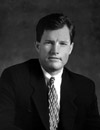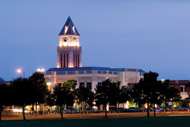| FEATURE ARTICLE, OCTOBER 2007
TEXAS RETAIL ROUNDTABLE
Interviews by Stephen O’Kane
Texas is experiencing a boost in jobs and population, which is creating opportunities for retailers and developers. Mixed-use and lifestyle developments lead the current trends in the state, while other retail continues to remain strong. Texas Real Estate Business interviewed brokers, developers and lenders across the state to discuss the current retail trends. Interviewees included: Dan Watson, Archon Group; Eric DeJernett, CB Richard Ellis; Steve Triolet, CB Richard Ellis; Tim Young, KeyBank Real Estate Capital; Victor Melton, LMI Capital; Brad Bailey, Marcus & Millichap; Jerry Goldstein, Marcus & Millichap; Gar Herring, TheMGHerring Group; Kimberly Gatley, NAI REOC Partners; H. Dean Lane, NewQuest Properties; Tom Kier, Opus West; Edward Page, Page & Partners; Stephannie Mower, PM Realty Group; Alan Warren, Q10|Kinghorn, Driver, Hough & Company; Stuart Wernick, Quantum First Capital; Steve Zimmerman, The Retail Connection; Chuck Siegal, Rohde Ottmers Siegal Commercial & Investment Realtors; Mark Reeder, Staubach Retail; Jim Lemos, Texas Realty Capital; John Morran, Texas Realty Capital; David Saunders, Transwestern; Woody Mann, Jr., Vista Equities Group; G. Peter Jacob, Weaver, Davis & Jacob Realty Group; David Nicolson, The Weitzman Group.
DALLAS/FORT WORTH
TREB: Can you give our readers an overview of the Dallas/Fort Worth retail market?
 |
Steve Zimmerman, The Retail Connection
|
|
Zimmerman: Dallas/Fort Worth’s housing market, job growth and infrastructure continue to underpin a very strong platform for retail real estate. In contrast to the uncertainty in the national housing market, base demand in the Dallas/Fort Worth area has remained solid. Dallas/Fort Worth’s infrastructure (highways, schools and hospitals) continues to improve and makes the Dallas/Fort Worth area a great place to live, as recognized by the recently released article by Money Magazine, which ranked Dallas as the Number 2 best place to live in the U.S. among all big cities. Retailers continue to expand their presence in the market, absorbing 1.5 million square feet for the first half of 2007, and overall occupancy remains stable at approximately 90.4 percent.
Herring: From our experience in regional development, we view the Dallas/Fort Worth market as very strong right now. We are seeing a lot of new development in the suburban areas with several major mixed-use projects expected to open next year.
 |
Steve Triolet,
CB Richard Ellis
|
|
Triolet: If you look at the fundamentals for Dallas/Fort Worth, comparing the mid-2007 with 1 year ago, the occupancy and rental rates are basically flat, while net absorption is up. With absorption improving, you think that would push the occupancy rate higher, but construction activity has balanced out the strong positive net absorption. In the second quarter, for example, 2.3 million square feet of space was completed, roughly a third of what was vacant upon delivery.
Reeder: The Dallas/Fort Worth retail market has continued to see growth into 2007. Currently there are over 11 million square feet of retail under construction, with the largest project being the Village at Fairview in Allen with more than 2 million square feet of retail. One of the big reasons the Dallas/Fort Worth retail remains strong is due to the increase in job growth. Dallas/Fort Worth ranks first in annual job growth amongst the MSA across the nation, producing more than 90,000 jobs in the area with over 20,000 of those jobs being in professional services. There are 21 active malls in the Metroplex with Northpark Mall being the largest at 1.9 million gross leaseable square feet.
TREB: What are the current trends in retail development in Dallas/Fort Worth?
Watson: A current trend in the market is the continued innovation in developing centers with lower building costs while maintaining high-quality designs and shopping environments. Also, additional creativity and flexibility on the part of the retailers and developers in bringing combinations of retailers not previously in the same center together.
Zimmerman: The trend toward urbanism continues with several mixed-use lifestyle centers being announced. Developments such as the 275,000-square-foot Lake Highlands Town Center, which will also include 1,600 residential units, and The Glen at Preston Hollow, a 175,000 square foot center, which will include 1,200 apartment units and more than $1 million homes, are located in the well-established Dallas neighborhoods of Lake Highlands and Preston Hollow. These developments combine hard and soft goods, specialty retail, dining and entertainment, and in many cases both residential and office — giving the consumer the opportunity to have it all while completely revitalizing areas that have been overlooked for years.
 |
Gar Herring, The MGHerring Group
|
|
Herring: There is a clear trend toward upscale lifestyle centers and true mixed-use developments, instead of the indoor mall that we all grew up with. We are also starting to see mixed-use developed on a grander scale.
Triolet: Several retailers are decreasing their footprint on new locations. More traditional big box retailers like Best Buy, Circuit City and Bed Bath & Beyond are opening smaller locations with lower operating costs. This trend is really just beginning here locally, but I think it will become more common over the next few years.
Reeder: Retail trends not only in Dallas/Fort Worth but across the nation have focused on providing the consumer with a shopping experience. The creation of the mixed-use development presents the shoppers with this experience, offering a variety of accommodations, for example the W 7th development in Fort Worth will offer a hotel, office buildings, several destination dining restaurants, a movie theater, a gym, 350 apartments and other retail. The idea is to create an atmosphere that is inviting to many different kinds of shoppers and will in turn increase the traffic to the center and bring a constant flow of consumers throughout the day.
TREB: Where is the majority of retail development taking place? Why?
Zimmerman: The Dallas/Fort Worth Metroplex is truly a 360-degree market with growth in every direction fueled by a steady supply of reasonably priced homes, job growth and improved highway infrastructure through state-funded improvements.
Herring: In Dallas/Fort Worth, we are currently experiencing a great deal of new development in the suburban areas. Just north of Dallas, areas such as Allen and Fairview are seeing a boom in retail development, continuing the trend toward strong residential growth and easy access to major highway systems. There is also strong growth in Cedar Hill, located in southern Dallas County. We will open an 800,000-square-foot lifestyle center in Cedar Hill in March 2008.
The suburban retail growth will continue because customers are demanding it. People don’t want to travel far to do their shopping, see a movie, or enjoy an upscale meal — they want to do it all in one convenient location.
Triolet: A majority of the development within the Metroplex is taking place in the Mid-Cities and Far North Dallas due to the new housing developments in those areas. Almost all of the outlying suburbs continue to expand with new retail inventory, especially the far north region of the Metroplex.
TREB: Do you have any retail projects underway or planned?
Zimmerman: There is Allegiance Development’s 400-acre master-planned project called Rayzor Ranch in Denton, which will ultimately include approximately 2 million square feet of retail. Weber and Company has several Target-anchored centers including those located at US 380 and US 75 in McKinney; Wheatland and I-20 in Dallas; the southwest corner of the Dallas North Tollway and Eldorado Parkway in Frisco; and the southeast corner of Highway 360 and Camp Wisdom in Grand Prairie.
Watson: We are currently under development with Alamo Ranch containing 960,000 square feet of retail, and are just finishing development of Prestonwood Town Center with 280,000 square feet. We also have four potential projects, each with 400,000 to 600,000 square feet planned that may be underway in the next 12 months.
Herring: We currently have more than 4 million square of retail under development, including three projects in the Dallas area.
Uptown Village at Cedar Hill is an 800,000-square-foot lifestyle center anchored by Dillard’s and Barnes & Noble. It is the first upscale, open-air lifestyle center in Cedar Hill. Opening date is March 12, 2008.
The Village at Fairview is a mixed-use development anchored by Dillard’s, Macy’s and JCPenney that will feature more than 1 million square feet of retail. In addition to the anchors, the project includes tenants Barnes & Noble and The Container Store; 500,000 square feet of specialty retail and restaurants; 200,000 square feet of office space; more than 1,000 multifamily residential units; Village Roadshow Gold Class Cinema; and a 280-room Embassy Suites Hotel with an adjoining 80,000-square-foot convention center.
The Village at Allen is a mixed-use development that includes a 900,000-square-foot power center. The project features 1 million square feet of retail including big box tenants, specialty shops and restaurants. It also includes 500,000 square feet of office space, the 7,500-seat Allen Event Center and a 225-room Courtyard by Marriott Hotel.
The Village at Fairview and The Village at Allen are being developed as one project, located at Stacy Road and Highway 75 in Fairview and Allen. Both will open in October 2008. Upon completion, the 400-acre mixed-use development will feature more than 2 million square feet of retail and 1 million square feet of office, residential and hotel space.
Triolet: There are several major retail projects currently underway. In fact, what gives me the most concern for the future fundamentals for the market is the level of new construction. With more than 13.7 million square feet under construction, this is the highest level we’ve seen in more than 10 years.
TREB: Are you seeing more big boxes or smaller tenants coming into your market? Are there any new retailers entering the market?
Zimmerman: The Dallas/Fort Worth market continues to be one of the premiere retail markets in the United States with retailers of all sizes, categories and concepts entering and expanding through the market, capitalizing on the strong consumer spending.
Triolet: Our market has a constant churn of retailers that have entered and exited the market in recent years. Mervyn’s and Gabberts, for example, pulled out of North Texas, while IKEA, The Dump and others have moved in. The retail industry is very dynamic; there’s always someone closing up shop, while new concepts take their place. That’s one of the many things I like about tracking the retail market, the evolution of the marketplace is very exciting to me.
TREB: Who are the active retail developers?
Zimmerman: Active retail developers include The MGHerring Group, with approximately 2.25 million square feet under construction; The Retail Connection/Connected Development Services, with over 2 million square feet; Allegiance Development, with approximately 2 million square feet; and Weber and Company, with approximately 1.5 million square feet.
Triolet: There’s a good mix of folks out there, but Direct Development and Rubloff Development Group are two of the more active developers locally.
TREB: What does the leasing market look like?
Zimmerman: The national economy will certainly have some effect on the local area; however, we expect the overall leasing market to stay extremely healthy due to the underlying strength in the market. The recent fluctuations in the financial markets will actually be a stabilizing force in maintaining a healthy balance between supply and demand by causing certain developments that are not well-anchored to be delayed. Overall our clients are bullish on the Dallas/Fort Worth area for 2008 and are actively seeking expansion opportunities.
Triolet: The market varies quite a bit by what submarket you’re in and what type of shopping center it is. As a general rule, the newer shopping centers are performing best, while older shopping centers, particularly some grocery-anchored centers in first-ring suburbs, have been having a difficult time keeping occupancy rates up while maintaining healthy rental rates.
 |
Mark Reeder, Staubach Retail
|
|
Reeder: The leasing market is still very active but we are seeing a slow down from previous years. Tenants are taking longer to make decisions and are being more selective, but they are still doing deals. The high triple nets are hurting the smaller shops; this is mostly due to the high taxes being charged by the cities.
TREB: What are the vacancy rates?
Zimmerman: The overall Dallas/Fort Worth vacancy rate is plus-or-minus 10 percent and we expect that balance to continue for the foreseeable future.
Triolet: With the construction activity at 10-year highs, I anticipate that vacancy rates will increase a percentage point or two over the next couple of years as the new shopping centers are delivered to the market.
Reeder: Shopping centers are at 11.2 percent, while general retail is at 8.5 percent and other retail is at 4.4 percent.
TREB: What is the retail lending climate in your area and how does it compare with the other Texas markets? Nationally?
 |
Tim Young, KeyBank Real Estate Capital
|
|
Young: The lending environment remains very strong and competitive despite the current turmoil in the capital markets. In today’s environment, lenders are expecting solid pre-leasing and there is less reliance on letters of interest (LOI). According to retail developers, big box retailers are continuing to move into or expand in the Dallas/Fort Worth market, as well as other major Texas markets such as Austin, San Antonio and Houston.
Wernick: The retail lending climate in Texas is still active with respect to new developments or for assets that are in the reposition mode. Many of the banks that have been competing with their mini-permanent products after construction are now being sought after because the conventionally conduit lenders who historically have taken the banks out after the construction period are sitting on the sidelines. Additionally, in the permanent market the life companies are showing resurgence as well. However, they are quickly getting tapped out due to funding allocation and are showing signs of quality selectiveness.
TREB: How is the investment climate in and around your area?
Young: Investors continue to demand a strong appetite for well-located retail developments with high-quality tenants. Investors in new construction also are looking at the experience and track record of the developer to minimize their risk. Private equity is continuing to chase high-quality deals; however, shopping centers that are not well-leased or lack a good sponsorship probably will not be able to get financing.
 |
Stuart Wernick, Quantum First Capital
|
|
Wernick: Although the credit markets have affected investments, there still is plenty of capital looking for product in our markets. Risk adjustments are being calculated in the investors pricing. The smaller buyers, who recently had relied on financial engineering to win deals, are now opening the field again to the institutional investors whose capital is more readily available to close quickly. However, this is allowing the institutional investor to price an acquisition at a level that is more appropriate for their needs.
TREB: What type of retail projects, properties or retailers are lenders interested in?
Young: Lenders prefer retail projects with high-quality anchor tenants or strong shadow anchor tenants, preferably located in markets that continue to offer strong job growth. Households are still being created in Texas even though there may be less reliance on single-family home developments due to the slow down. But, rental housing is still strong and these households also require retail nearby, particularly the grocery-anchored shopping centers and big box retail developments.
Wernick: There is nothing new on this front. Lenders are looking for the well-located assets with strong credit tenants or retailers with strong sales. Single-tenant big box users also are a preferred product. However, for those single-tenant properties, lenders are starting to refocus how those properties are being insured.
TREB: What do see you in the near future for the retail market in Dallas/Fort Worth?
Herring: As the demand for live/work/play destinations continues to grow, retail development, specifically mixed-use, will thrive in the Dallas/Fort Worth area. I think we will continue to see more retail development moving north and west as these areas continue to build out.
Zimmerman: We see a continued emphasis on urbanism and development of mixed-use lifestyle type centers both in suburban and urban areas. Areas to keep an eye on include McKinney, Allen, Fairview, Prosper, Uptown Dallas and Northwest Tarrant County/Alliance Corridor.
Triolet: I think there’s some over-building going on, so I think it’s important to watch those submarkets with abundance of new construction in the pipeline. For a few of them, the population growth justifies the new projects, but in some others, the current and projected population growth does not support them in the short term. Newer retailer projects tend to outperform the market, so this over-building won’t hurt the developers and owners on the new inventory as much as it will the older, existing centers that they currently compete with.
Watson: As long as the economic and job growth fundamentals continue, Texas will experience solid growth. The current uncertainties in the credit markets, and the tougher underwriting by lenders currently in place, will result in larger and smaller developers creating innovative joint venture structures to get certain projects built to meet the needs of key anchor retailers.
THE PLAZA AT ROCKWALL TO OPEN THIS FALL AT INTERSTATE 30 AND HIGHWAY 205
Scheduled to open this fall and throughout the first quarter of next year is The Plaza at Rockwall, a retail development of Fort Worth, Texas-based The Woodmont Company in Rockwall. The regional shopping center hopes to attract families in Rockwall and the surrounding areas.
The Plaza at Rockwall, which is located on the southwest quadrant of Interstate 30 and Highway 205, will blend large-scale power center attributes with the familiar feel of a specialty center, giving it a wider appeal. Upon completion, the development will offer approximately 475,000 square feet of retail space.
The Woodmont Company is familiar with this area as it has developed the adjacent 225,000-square-foot retail property, Rockwall Crossing. The company had an opportunity to acquire land next door to Rockwall Crossing and develop it into a larger center offering Rockwall residents more of the tenants they wanted.
The Plaza at Rockwall was designed by Architecture+ and CNLRS Rockwall, a Texas-based partnership, owns the development.
— Stephen O’Kane |
West Love Market to Fill Need for Quality Retail in Underserved Urban Area
Balcones Realty Partners, the development arm of Golden Boy Partners, is set to begin construction next April on West Love Market, a $90 million, 365,000-square-foot retail center near Love Field Airport in Dallas. The project, which is being leased by Falcon Realty Advisors, is redeveloping a 37-acre site on Mockingbird Lane in between Maple Avenue and Forest Park Road.
“What makes this project different is that Balcones is going into an area underserved by quality retail options and commerce and is changing that to improve and provide convenient quality options to residents,” says Jorge Ramirez, managing partner for Balcones Realty Partners. “West Love Market also will cultivate a sense of community.”
The center is being designed to complement the neighborhood, taking influences from both historic and contemporary architectural styles found throughout the city. Adding to the community feel, there will be a 2-acre park featuring green space for the surrounding neighborhood located adjacent to the center.
“The project will be a success because it has received support from area residents and Councilwoman Pauline Medrano, who oversees this district,” Ramirez says. “We also are receiving a great deal of interest from big box retail chains to mid- and smaller-sized retail and service providers that want to be located in West Love Market and to be a part of this unique development project.”
— Lindsey Walker |
HOUSTON
TREB: Can you give our readers an overview of the Houston retail market?
 |
Edward Page,
Page Partners
|
|
Page: Houston’s current rank as the highest number of new home starts in the country, along with the position of leading job growth in the nation, continues to support healthy retail growth in our market. New retail development within the Houston area encompasses power centers, grocery-anchored centers, even more strip centers, lifestyle and town centers, multi-use and mixed-use projects, and outlet centers. Both national and local retail developers have been active in the market.
Goldstein: The retail market in Houston continues to be vibrant. According to O’Connor & Associates’ latest quarterly report, 918,383 square feet of retail space was absorbed in the second quarter of 2007 and nearly 3.32 million square feet of space has been absorbed in the last 12 months.
Mann: My perspective is that Texas continues to be one of the stronger retail markets in the country. Job growth throughout Texas continues to outpace that of the rest of the country and the economy throughout the state seems to be solid. Investment dollars continue to flow into the state from outside markets and the retail sector seems to garner a majority of those dollars.
TREB: What are the current trends in retail development in Houston?
Mann: The most prevailing trend underway seems to be that of mixed-use lifestyle developments. Although the term lifestyle has been abused, true mixed-use lifestyle developments that combine various disciplines, such as retail, office and/or residential are where major developers seem to be focusing their efforts — both in suburban and urban in-fill locations as well.
 |
H. Dean Lane, NewQuest Properties
|
|
Lane: Larger projects with more community design and other uses such as office, hospitality, residential, park-and-ride facilities, entertainment and new innovative uses are driving forces in today’s retail development projects.
Developers are more prudent with just building a shopping center, pre-leasing a significant part of the project before starting construction. Pre-leasing paired with a strong design is critical in creating a long-term successful project. Also, with the changes in the lending market, pre-leasing and financial strength are vital.
Large retailers such as JCPenney, Sears, Macy’s and Dillard’s must consider stand-alone stores to survive because there are not enough malls being built in the country to satisfy the large department stores’ growth schedules. The convenience factor also drives the free-standing concept.
TREB: Where is the majority of retail development taking place? Why?
Page: Regions such as far West Houston, The Woodlands in North Houston, Pearland in South Houston and League City in Southeast Houston have increased development following the residential growth in these areas. Additionally, within Beltway 8, we are seeing primarily multi-use projects being developed in in-fill areas catering to existing underserved markets.
 |
Jerry Goldstein, Marcus & Millichap
|
|
Goldstein: Given our population growth of approximately 150,000 residents per year, developers are building in most of Houston’s suburban and urban population centers. There has been a lot of focus on the Pearland market recently. CBL & Associates Properties is currently developing the 1.2 million-square-foot Pearland Town Center at Texas 288 and FM 518. This mixed-use development is going to be anchored by Dillard’s, Macy’s and Barnes & Noble, and CBL recently announced that other tenants will include GNC, Chico’s, White House|Black Market and Ann Taylor Loft, among several other prominent national tenants. This is very impressive because Pearland was at best a Wal-Mart-type suburban market with Target considered upscale about 5 years ago.
Mower: Mixed-use is the primary in-town development due to the density of population and scarcity of available land. Developers are looking more to improve infill locations with stronger retail and focusing on strong demographics.
Lane: Overall development is spiking in most growth areas with some infill when the redevelopment presents itself. New retail development is taking place in strong suburban growth markets, where there is a minimum of 50,000 houses on the ground with good household income. There is also a lot of new retail activity in small markets and border markets.
TREB: Do you have any retail projects underway or planned?
 |
G. Peter Jacob, Weaver, Davis & Jacob Realty Group
|
|
Jacob: Yes. One of our current projects is The Crossing at Telfair. We broke ground last month on Phase I of this project called Bonaventure Plaza. The Crossing at Telfair is a 112-acre mixed-use commercial development project in Sugar Land consisting of office, medical, retail, restaurants and a hotel.
Also, Sienna Village is a new retail development at Highway 6 and Sienna Parkway in Missouri City that will feature 90,000 square feet of retail including five pad sites for banks, shops and restaurants, and a new 113,771-square-foot H-E-B Plus! that will open in late 2008.
Oyster Creek Crossing is a 16-acre tract of land on State Highway 6 and Trammel-Fresno. This mixed-use development will serve several communities including Sienna Plantation and will be a great fit for single-business end-users such as service establishments, banks and quick-service restaurants.
The Crossing at Sienna Ranch, located on Sienna Parkway, just South of Highway 6, will feature both office and retail space including a 15,000-square-foot retail center.
 |
LaCenterra at Cinco Ranch is a 260,000-square-foot mixed-use, town center development in the West Houston/Katy area that contains 170,000 square feet of specialty retail and restaurant space and 90,000 square feet of Class A office space.
|
|
Rocky Creek Crossing is an 8-acre retail development consisting of retail and restaurants. The Offices at Rocky Creek Crossing were recently completed, making the two projects a dynamic mixed-use development.
Page: From the regional mall category, both The Grand and Pearland Town Center have been added to the mix, as well as the latest outlet mall for our market, Houston Premium Outlets. We are also seeing new power centers such Fairfield Place Town Center and the center at Westheimer and Dairy Ashford. LaCenterra at Cinco Ranch Phase II and the expansion of Market Street, both lifestyle centers with leasing underway, continue to gain momentum. Mixed-use projects in store for Houston include CityCentre, High Street, Boulevard Place, River Oaks District, West Ave., Regent Square and Sonoma.
 |
Woody Mann, Jr., Vista Equities Group
|
|
Mann: We have just completed Phase I of LaCenterra at Cinco Ranch which is a 260,000-square-foot mixed-use, town center development in the West Houston/Katy area that contains 170,000 square feet of specialty retail and restaurant space and 90,000 square feet of Class A office space. Construction on Phase II of LaCenterra began last month, and will contain an additional 150,000 square feet of specialty retail and restaurant space along with 250 Class A residential units.
In addition, we are beginning construction this fall on the infrastructure for The Reserve at Grand Parkway, which is an 89-acre mixed-use development on the Grand Parkway in Houston that will contain medical, office, residential, and retail/restaurant space.
TREB: Who are the active retail developers?
Goldstein: The usual suspect developers — Trademark Development Company, Wulfe & Company, The Ainbinder Company, Fidelis and MetroNational — continue to be active here with top-tier developments. In addition, however, less active players in Houston’s development market are making big waves. For example, GID Urban Development Group is moving forward with its planned Regent Square on the soon-to-be former Allen House site on a prominent 20-acre site fronting Allen Parkway near River Oaks.
Page: NewQuest Properties, CBL & Associates Properties, Gulf Coast Commercial Group, Read King Commercial Real Estate, Simon Property Group, Property Commerce and Chelsea are the first that come to mind.
TREB: Are you seeing more big boxes or smaller tenants coming into your market? Are there any new retailers entering the market?
Page: Among the big box retailers, Staples, Dick’s Sporting Goods and HomeGoods all plan to enter the Houston market. Various new restaurants have plans here as well, including Houlihan’s, Celebrity Bakery, The Counter, Baker Bros American Deli, FatBurger and Eddie V’s Edgewater Grille. To add to their existing locations, la Madeleine anticipates several additional stores. Specialty retailers including lululemon athletica, Crazy 8, Sweet & Sassy and Sprinkles Cupcakes have also made the decision to come to Houston.
Goldstein: Big box retailers are adding stores in the Houston market. Recent press releases have indicated that Best Buy, Academy Sports + Outdoors, The Home Depot and Kohl’s are all planning to open a minimum of two new stores by the end of the year. In addition, there are a variety of smaller retail concepts that are entering the Houston market for the first time.
TREB: What does the leasing market look like?
 |
Stephannie Mower, PM Realty Group
|
|
Mower: Second quarter 2007 shows that occupancy is down 0.38 points (compared with the previous quarter) to 85.36 percent occupancy, with rental rates $0.02 lower per square foot. The leasing market is still strong; however, with retail sales slowing, stronger scrutinization on new locations can be expected. There was 918,000 square feet of space absorbed during the second quarter.
Page: There continues to be a strong demand for existing and proposed products. Adversely, the unanchored strip center leasing market appears to be softening to some degree.
TREB: What are the vacancy rates?
Goldstein: The overall vacancy rate in Houston is a little over 14 percent. Of course, there are certain submarkets with higher and lower occupancy rates, but overall we’re experiencing above average absorption in a growth retail market.
Mower: An estimated 4.2 million square feet of new retail space will have been completed by the end of the year, a 17 percent increase over last year. Department stores and supermarkets will account for 17 percent and 15 percent of that, respectively.
TREB: What is the retail lending climate in Houston and how does it compare with the other Texas markets? Nationally?
 |
Victor Melton,
LMI Capital
|
|
Melton: Retail lending in the Houston area has been rather strong at this point in time. This is a direct reflection of the strong energy market, population growth and our impressive job market. The Houston area continues to experience growth from its suburbs, especially The Woodlands, Sugar Land, Katy and Pearland. I would rank Houston as the top market in Texas for retail lending, with the San Antonio area as being a stable second. The Dallas/Fort Worth area and Austin are probably not as strong, but they certainly have submarkets with excellent performance taking place.
TREB: How is the investment climate in and around your area?
Melton: All in all, I think the outlook is very favorable. Houston is fortunate in that we have a number of factors in our favor, including our diversified economy, excellent job growth forecast, housing stock in balance to support the new and existing retail projects in the area, and positive population growth. We are seeing more out-of-state money coming in to invest in our projects, which are considered bargains.
TREB: What type of retail projects, properties or retailers are lenders interested in?
Melton: Lenders are always interested in financing retail projects that possess the basic fundamentals of great location, good tenant mix with national and local retailers, no concentrated rollover of leases in any given year and the rooftops to support it. Lifestyle centers and open-air market properties are very well received. Single-tenant retail properties are still financeable, provided the credit behind the lease is strong. Power centers are also good, based on the anchors. Discount retailers may become more popular, should the economy start to slow down.
TREB: What do see you in the near future for the retail market in Houston?
Goldstein: I think one of the primary up-and-coming markets in Houston is Pearland. Since 2000, Pearland’s population has grown by nearly 93 percent. As a result, we’re seeing a lot of development as retailers vie for the business of those residents. To keep pace, voters in Pearland recently approved a $162 million bond issue intended to add major roadway and drainage projects as well as recreational upgrades.
Mann: I think that the retail market in Texas will remain strong in the near future, barring a geo-political event over which we have no control, or an implosion in the capital markets due to the sub-prime mortgage market. As long as we have continued job growth, low unemployment, continued population growth and a vibrant residential market, I believe that we will continue to see a strong retail market in Texas, compared to other areas in the country.
Jacob: We see continued growth in retail development in the coming year, especially in Fort Bend County. The market may not be as aggressive as it has been over the last 5 years, but as long as the Houston local economy remains strong, especially in the oil industry, we should stay on a healthy growth curve.
Mower: Density in the downtown area is impacting development. An increase in multi-unit housing close to the center of town and redevelopment such as Post Oak, compounded by Houstonians’ desire to stay out of traffic, are contributing to a strong effort toward a 24-hour downtown.
MARCEL INC. TO OPEN BOUTIQUE LIFESTYLE CENTER IN KATY THIS WINTER
Houston-based Marcel Inc. is bringing a new boutique mixed-use lifestyle center to Katy this year. The Villagio, located at the northeast corner of Westheimer Parkway and Peek, will span a total 112,285 square feet when it celebrates its grand opening in December.
The Villagio will offer 77,468 square feet of retail and restaurant space. The project is already more than 65 percent leased to 17 prospective tenants that include Berryhill Baja Grill, Azzarelli’s Italian Restaurant, French Bakery, Japanese Steak and Sushi Bar, Buffalo Wings and Rings, Ya Ya’s Clothing, Gina’s Accessories, Salon De Vero, Bookworm and Rosenburg Jewelers.
In addition to the large retail portion, the approximately 12-acre development will house 33,041 square feet of office space and a four-level paring garage. Prospective office tenants for The Villagio include Cinco Family Dentistry, Cinco Travel and Network Funding Mortgage. There also are nearly 4 acres positioned directly behind the project that remain available for possible residential or office developments.
The Villagio represents a new direction for Marcel Inc., as its past projects solely included single-use build-to-suit projects or renovations. The $22 million development is company’s first venture into mixed-use projects. While Marcel Inc. plans to build similar boutique developments in the future, the company will continue with smaller land acquisitions.
— Stephen O’Kane |
SAN ANTONIO
TREB: Can you give our readers an overview of the San Antonio retail market?
 |
David Nicolson, The Weitzman Group
|
|
Nicolson: San Antonio’s retail market continues to report a notable balance of supply and demand for retail real estate, thanks to retailer demand for space and construction with strong pre-leasing. Currently, the overall retail market reports an occupancy rate of 91 percent, making San Antonio the strongest retail market in Texas, based on occupancy. Our occupancy rate is based on a retail market inventory of approximately 29 million square feet.
Siegal: The retail market remains fairly stable in the Texas market, however there are signs of tougher times ahead. It has become increasingly difficult and time consuming to finalize leases for national or strong regional tenants, particularly for anchor and junior anchor tenants. Concessions to the tenants on rent, TIA and rent commencement dates are extremely negotiable and the ranks of these strong tenants needed to make the development successful and attract smaller tenants are rising.
 |
Kimberly Gatley,
NAI REOC Partners
|
|
Gatley: The San Antonio retail market continues its expansion phase characterized by substantial new development and rising rental rates. Fueled by both population and job growth, the Alamo City has seen 6 consecutive years of record-breaking residential development and naturally retail is following those rooftops.
Saunders: In San Antonio, retail seems to be the preferred product type among developers. As such, the market has seen a steady increase in supply in recent years. Several drivers are causing this growth, which is primarily localized. Retailers expanding into the San Antonio market, newly delivered properties and planned developments are providing numerous opportunities to accommodate this demand. This growth shows no signs of slowing down.
TREB: What are the current trends in retail development in San Antonio?
Nicolson: We’re seeing several trends. One is redevelopment. For example, a renovation was recently completed on Lockhill Village, a community center anchored by H-E-B at the intersection of Northwest Military and Lockhill Selma. One of the highest-profile redevelopment projects is Park North Plaza, the redevelopment of the old Central Park Mall. The center’s plans call for more than 1 million square feet of space for department and discount stores, as well as in-line space and entertainment venues. Approximately 30,000 square feet of small shop space is opening this year, following the completion of an equal amount of space in 2006. We’re also seeing extremely large retail projects that aren’t malls, but their locations and tenant mixes help provide the same regional draw as malls. Projects that fall in this category include the The Rim.
San Antonio also is seeing a number of expansions. The Shops of La Cantera, San Antonio’s newest mall, is planning a 300,000-square-foot expansion to open in 2008. Neiman Marcus, Nordstrom, Macy’s and Dillard’s anchor the upscale mall.
Saunders: Income levels continue to climb as the market attracts more white-collar industries. Income also affects retail type; the higher the income in a particular area, the more affluent the overall demographic. Retailers catering to this demographic, thus, begin to emerge. In recent years, San Antonio has welcomed elite boutique tenants, including Neiman Marcus, Nordstrom’s and Tiffany & Co. — retailers that never considered San Antonio a viable market in decades past.
Gatley: The Urban Village appears to be the emerging trend in development. The redevelopment of three historic downtown buildings is creating the Piazza San Lorenzo, a mixed-use project that calls for river and street-level retail and restaurant space along with upper-level office space and high-end residential units. Outside of downtown, the Main Street concept translates into a “suburban” village. The Reflection proposes more than 500,000 square feet of retail, office, hospitality, dining, entertainment and multi-story residential space opportunities at the intersection of Blanco and Huebner.
TREB: Where is the majority of retail development taking place? Why?
Nicolson: Currently, one of the biggest areas for development can be found along San Antonio’s major thoroughfares, most notably Loop 1604. Major projects along the Loop include the newest phase of The Rim, located at Interstate 10 and Loop 1604, across from The Shops at La Cantera mall. During 2006, 673,500 square feet opened in The Rim, and the project is set to have 2 million square feet upon completion. The Rim continues to add retail and restaurants, and in early 2008, Life Time Fitness will open a 150,000-square-foot health club. In addition, The Village at The Rim, a planned 300,000-square-foot specialty retail mixed-use project, will also be a part of The Rim project. Also along the Loop is Hill Country Plaza, a 350,000-square-foot center set to open this fall at Loop 1604 and Northwest Military Highway. The center will feature a 77,000-square-foot Academy Sports + Outdoors. Another major project along Loop 1604 planned for 2008 or later is Alamo Ranch, located at the southwest quadrant of Loop 1604 and Culebra, which is expected to have 900,000 square feet upon completion. The project, designed to have three major anchors and 10 junior anchors, is under way for a summer 2008 opening.
 |
Chuck Siegel, Rohde Ottmers Siegel Commercial & Investment Realtors
|
|
Siegal: Retail development is occurring primarily in new areas with significant home growth. In San Antonio, this has been in the extreme northwest and north central part of the city and Bexar County. New home and sales of land for residential use has fallen dramatically in the last few months; this will definitely call a slowdown in future retail developments. Many land speculators who have purchased significant acreage in the past few years will be hurt.
TREB: Do you have any retail projects underway or planned?
Nicolson: Weitzman’s sister company, Cencor Realty Services, has several projects in the works, including Lockhill Village, which I mentioned before. A couple of Cencor’s projects are expansions, including the expansion of Culebra Market, a project anchored by H-E-B at the southeast corner of Loop 1604 and Culebra Road. The expansion, to be complete this year, is adding retailers such as Office Depot. Another expansion involves the Village at Forum Parkway, a center at the northwest quadrant of I-35 and Loop 1604 that features Ethan Allen, Bassett Furniture Direct and Chuck E. Cheese’s. The center is being expanded for Circuit City and Office Depot. Another project, which is just being completed, is Four Oaks Plaza, at the intersection of FM 3009 and I-35. The center features 30,000 square feet of multi-tenant retail, as well as three pad sites, and is peripheral to a new Wal-Mart Supercenter.
TREB: What does the leasing market look like?
Gatley: According to the survey of more than 38 million square feet of competitive retail properties conducted by NAI REOC Partners, gross leasing activity in the first half of the year yielded 224,322 square feet of positive net absorption. Countered by the addition of 274,000 square feet of new development, the citywide vacancy rate fluctuated to 10.8 percent compared to 10.5 percent recorded last year at this time. The citywide vacancy changed only slightly despite new space coming on line — an indication of equilibrium between supply and demand.
TREB: What are the vacancy rates?
Gatley: Breaking the market down by property type, power centers lead all other categories with the tightest vacancy rate and highest rental rates. At the close of the second quarter, power centers posted a citywide vacancy rate of 4.4 percent compared to 4.1 percent last year at this time. The quoted rental rate for space in power centers currently averages $24.69 per square foot annually on a triple net basis, up $1.71 for an annual increase of 7.4 percent.
Regional malls reported a second quarter vacancy rate of 5.8 percent compared to 7.3 percent a year ago, before North Star Mall leased 180,000 square feet to JCPenney, which opened in August.
Community centers posted a second quarter vacancy rate of 7.2 percent compared to 9.2 percent a year ago. The quoted rental rate for space in community centers currently averages $16.41 per square foot annually on a triple net basis, up $0.73 for an annual increase of 4.7 percent.
The influx of new neighborhood center space countered positive net gains resulting in a citywide vacancy rate of 16.4 percent compared to 14.7 percent a year ago. At the same time, the average quoted rental rate climbed $0.48 to $13.44 per square foot annually on a triple net basis for an annual increase of 3.7 percent.
Finally, strip centers posted a citywide vacancy rate of 14.5 percent after experiencing 33,714 square feet of positive net absorption in the second quarter. Vacancy remained stable compared to 14.4 percent vacancy recorded last year at this time but rental rates rose $0.79 or 5.3 percent over the year to reach $15.61 per square foot annually on a triple net basis.
TREB: What is the retail lending climate in San Antonio and how does it compare with the other Texas markets? Nationally?
 |
Alan Warren, Q10|Kinghorn, Driver, Hough & Company
|
|
Warren: All of the lenders that we work with have a very strong interest in funding loans in San Antonio. None of our lenders have over exposure in San Antonio (and South Texas) as may be the case with other (national) markets.
TREB: How is the investment climate in and around your area?
Warren: The retail investment climate remains healthy because of the overall strength of the local commercial real estate market. The San Antonio retail markets now measures more than 100 million square feet of space with an overall vacancy rate of only 7 percent. Fueling this demand for retail product are stellar demographic trends, including population growth more than double the national average over the past year. According to Property & Portfolio Research (PPR), this rapid pace of growth is forecast to continue through 2011. Retail construction remains robust in San Antonio, with over 6 million square feet scheduled to be completed in 2007. Sales activity has been strong with more than 30 major transactions reported during the past 12 months at a median price of $174 per square foot. The median cap rate for trades over this same period (where data was available) was 7 percent.
Gatley: Investment activity within the retail sector has slowed compared to previous years, not for lack of interest or capital but for lack of product on the market. Recent investment activity included the purchase of the 29,243-square-foot Potranco Road Shopping Center by Houston-based Richland Investments from Option 1 Realty Group. Other sales included Bandera Trails, a 29,552-square-foot property, the 26,515-square-foot Oak Ridge Square Shopping Center, Parkwood Place, a 52,790-square-foot center and the 37,248-square-foot Cadillac Plaza.
TREB: What type of retail projects, properties or retailers are lenders interested in?
Warren: Despite recent volatility in the capital markets, general account lenders (primarily insurance companies) and select CMBS lenders have maintained a healthy appetite for all types of well-located and leased retail properties in San Antonio and South Texas.
Anchored and un-anchored retail centers located in areas with strong demographic trends, such as Stone Oak, the IH-10 corridor and the IH-35 corridor, continue to attract interest from life companies and CMBS lenders as evidenced by Q10|Kinghorn, Driver, Hough & Co.’s recent financing of Ventura Plaza located along Loop 1604 North with Aviva Capital Management.
TREB: What do see you in the near future for the retail market in San Antonio?
 |
David Saunders, Transwestern
|
|
Saunders: Throughout the market, San Antonio’s retail opportunities continue to grow. The entry of new industry leaders will only bolster this trend. As demand continues, San Antonio’s retail sector must make room for necessary expansion and development.
Nicolson: The future, like the present, is bright for the San Antonio retail market. The strength in the market results largely because the San Antonio area reports one of the strongest regional economies in the state, if not the nation.
Siegal: I see a continuing slowdown in consumer spending, except for the high-end consumers. This segment of the market has skewed the real numbers as far as retail sales, as what is left of a dwindling middle class and the lower end consumers have been suffering. Especially with high gas prices and increased interest rates, which often affect their mortgage payments as lenders have been very accommodating with creative lending that payments that in reality have said, “pay little now, but I’ll get you later.” Later is here.
Gatley: Even as the local housing market slows, it still remains healthy with 2007 expected to rank as third best on record based on MetroStudy’s mid-year projections for new home starts. Although the local retail market has been relatively quiet in the first half of this year, activity within projects expected to come on line by year-end will likely produce much stronger absorption numbers in the second half as developers work to get retailers into their spaces before the holiday season.
HPI RETAIL PARTNERS PLANS TO BREAK GROUND ON BULVERDE MARKETPLACE NEXT YEAR
San Antonio-based HPI Retail Partners, a division of HPI Real Estate Services and Investments, plans to break ground next year on Bulverde Marketplace, a 750,000-square-foot retail development at Loop 1604 and Bulverde Road in Northeast San Antonio. To feature more than 60 tenants, including a discount anchor and an assortment of restaurants, the project will fill the need for a large, quality shopping environment in the area.
Within a 3-mile radius of the development, there is a population of 72,000; more than 2,000 homes under construction; a new 1,000-room Marriott resort underway; and there are two golf courses being planned. These statistics, combined with the fact that there is no major shopping center between Loops 410 and 1604 east of US 281 and west of Nacogdoches, make the developers believe Bulverde Marketplace will be a unique and successful venture.
“Developers have tried for 25 years to acquire this property,” says Mark Granados, managing partner with HPI. “We got the deal done due to our ability to offer the sellers solutions to their individual goals. We are the dominant, large shopping center developer in the market and we have relationships with the right anchors for the project.”
RVK Architects is providing architectural services, and Pape-Dawson Engineers is the project engineer. Completion of Bulverde Marketplace is scheduled for 2009.
— Lindsey Walker |
WEINGARTEN REALTY AND CUMBERLAND 211 TO DEVELOP STEVENS RANCH TOWN CENTER
 |
Stevens Ranch Town Center
|
|
Weingarten Realty and Cumberland 211 are teaming up to bring a large-scale retail project on line in 2010. Scheduled to break ground next year is Stevens Ranch Town Center, a proposed 1.1 million-square-foot development located at the northeast corner of Potranco Road and Highway 211 in West San Antonio.
Stevens Ranch Town Center will be a part of a 2,500-acre master-planned community, which will feature, restaurants, custom homes, multifamily space and medical space. Its convenient location hopes to provide a shopping and dining destination for surrounding residents and workers.
“Stevens Ranch Town Center is conveniently located to many of the San Antonio’s employment centers including the 4,500 acre Westover Hills, a major business employment center, Toyota, Microsoft, World Savings, Chase Bank, Citicorp, South Texas Medical Center and others are located,” says Cyndee Smith, regional leasing director for Weingarten Realty. “There are approximately 100,000 employees within a 15-minute drive of Stevens Ranch.”
Using this location, Stevens Ranch Town Center hopes to attract a dedicated customer base to its 1.1 million square feet of retail. The town center will be the retail hub for West San Antonio as it is located off of Potranco, a major east/west corridor in the city that connects to San Antonio’s commercial districts.
“The community will be pleased to have quality retail stores in close proximity to their homes,” says Smith. “There has been significant interest from numerous big box tenants for a number of years to enter this market at the right time, which has finally arrived.”
— Stephen O’Kane |
AUSTIN
TREB: Can you give our readers an overview of the Austin retail market?
 |
Brad Bailey,
Marcus & Millichap
|
|
Bailey: Another year of favorable demographic and economic outlooks has generated elevated construction activity in the Austin metro thus far in 2007, with a record 4.6 million square feet of new retail space expected to come on line before year-end. Although the influx of new space is expected to push vacancy up in the near term, strong household and employment growth is forecast to render the decrease in occupancy levels temporary. In the Central/Downtown Austin submarket, the much-anticipated Hill Country Galleria is expected to add 1.1 million square feet of retail space to inventory by year-end. In addition, The Domain, a 760,000-square foot mixed-use project, is attracting high-end retailers to the development.
DeJernett: The tightening of the credit market in the U.S. could potentially affect development within all segments of commercial real estate. If home building is restricted by lack of easy capital then new retail development, which follows rooftops, could potentially slow. The current indication is that Texas is comparatively healthy to other states and is not suffering for the rapid increase in home values that the East and West Coasts experienced. Austin appears to be a strong market within Texas due to continued job and population growth. If these factors continue at the current pace, retail sales should remain strong.
Kier: Strong job growth and population growth continue to drive stable retail development. Historically, big box development has lead the majority of the square footage growth, however, this appears to be slowing with several players such as Wal-Mart and The Home Depot, which appear to be nearing saturation.
TREB: What are the current trends in retail development in Austin?
DeJernett: Current trends include mixed-use developments like the recent one from Opus Corporation in the Village of Bee Cave where multifamily, theater, lifestyle, department store and subsequent office product all exist within the development. Where Austin once had only a handful of retail nodes, now we have several emerging edge cities coming out of the ground. Developments such as The Domain, anchored by a Simon Property Group lifestyle development as well as an IBM Campus, and the Village of Bee Cave are prime examples. Another emerging trend is the first leg of the Capital Metro Commuter Rail Line scheduled to open in the fall of 2008. Projects are being planned for development around transit stops from downtown Austin to Leander and are providing various retail opportunities.
Kier: In recent history, power strip centers have lead the growth, which continues to be a strong growth vehicle. Traditional grocery-anchored centers have been fading for a number of years, with the acceleration of supercenter developments (Wal-Mart and Super Targets). As has been evidenced in many areas of the country, including the suburbs of North Dallas, the introduction of lifestyle projects in more affluent areas has been a growing trend. Fewer traditional malls are being constructed and more open-air centers are being built in its place. Also, Austin has most recently welcomed high-end retailers into their market.
TREB: Where is the majority of retail development taking place? Why?
 |
Eric DeJernett,
CB Richard Ellis
|
|
DeJernett: We see development in almost all of the surrounding submarkets of Austin due to the long-term expansion of job and population growth. Austin has achieved the market size necessary to support large retail and mixed-use developments. Submarkets like the Village of Bee Caves, Cedar Park, Kyle, Hutto and others all have significant projects proposed or underway.
Kier: Dallas, Austin, Houston and San Antonio have all shown stable growth in the past few years in the 6 to 8 percent range. All four cities rank nationally in the top 15 cities for 5-year population and job growth forecasts, suggesting that the stability of the markets should continue.
TREB: Do you have any retail projects underway or planned?
Kier: Hill Country Galleria in Bee Cave is a 1.1 million-square-foot mixed-use lifestyle project, which includes 770,000 square feet of retail; 220,000 square feet of multifamily residential; 40,000 square feet of townhouse residential; and 150,000 square feet of office space. The retail portion is anchored by Dillard’s, Cinemark Theatres, Barnes & Noble, Circuit City and Dick’s Sporting Goods. Other tenants include Aeropostale, Ann Taylor, Ann Taylor Loft, Banana Republic, Bath & Body Works, Chico’s, Coldwater Creek, Eddie Bauer, Finish Line, Hollister, Jos A. Bank, Journey, Limited Too, LensCrafters, New York & Co, Talbot’s, Victoria Secret, White House|Black Market, Zale’s Jewelers, Kay Jewelers, Walgreens and Mimi’s Café.
DeJernett: CBRE is actively involved in the development of a mixed-use transit oriented development at Crestview Station in Central Austin. We are also involved in the early stages of developments in the North and Northwest submarkets of Austin.
TREB: What is the retail lending climate in your area and how does it compare with the other Texas markets? Nationally?
 |
Jim Lemos,
Texas Realty Capital
|
|
Lemos and Morran: The Austin market continues to perform well above all Texas markets in terms of job and employment growth, market potential and, as a result, receives very high marks and unlimited investment focus from national lenders. In all respects, Austin is, and projected to remain, a top five market nationally in all lending categories.
While fundamentals in commercial real estate, especially retail, remain strong, credit markets that provide financing to the industry have been impacted by the fallout in the capital markets that started in the residential sub-prime sector this spring. The CMBS lenders, or conduits, that provided much of the aggressive financing that fueled lower and lower cap rates are no longer able to provide interest-only loans and must underwrite deals based on actual, in-place income. Additionally, the spreads have increased 50 to 100 basis points this summer, making interest rates higher than the first half of 2007. With conduit lenders largely on the sidelines, the large majority of the available financing will come from the portfolio lenders such as insurance companies, whose lending programs have much higher certainty of execution. The net result will be rising cap rates and a slow down in retail sales transactions.
TREB: How is the investment climate in and around your area?
 |
John Morran,
Texas Realty Capital
|
|
Lemos and Morran: Investors at local, regional and national levels all have Austin in their top five markets for acquisitions of retail and other asset classes due to Austin’s strong growth prospects and market performance. The big question today is: if other markets around the country slow down due to the changes in the capital markets, will the Texas markets be able to continue to buck the trend and maintain this level of transaction activity? With reports of more than two-thirds of the investment sales activity since 2004 coming from sources outside Texas, it would be hard not to expect some decrease in activity. Our forecast is that the impact on the institutional, core-type assets will be significantly less than on the smaller, more speculative properties.
TREB: What type of retail projects, properties or retailers are lenders interested in?
Lemos and Morran: Lender interest remains high for any anchored retail property, particularly grocery (H-E-B and Whole Foods), The Home Depot/Lowe’s Home Improvement Warehouse and of course Target and Wal-Mart. Funding for free-standing units of Walgreens, CVS/pharmacy and retail banking facilities continue to be plentiful.
On the other hand, un-anchored strip retail seems to be reaching a point that some locations are experiencing slower than expected lease-up and lenders are becoming more cautious, requiring the property to reach higher occupancy levels before funding full leverage loans.
TREB: What do see you in the near future for the retail market in Texas?
Bailey: The positive long-term economic outlook for the Austin metro will continue to be the indicator for the local retail investment climate. Competition from new construction will keep investors selective again this year; however, opportunities still exist. For single-tenant properties, which currently offer average cap rates in the low-7 percent range, nationally branded concepts in prime locations will garner the most investor interest. Some multi-tenant value-add opportunities still exist near the city center, where cap rates are currently trading in the mid-7 percent range, and high-end condominium developments continue to increase population density. Investors willing to tackle occupancy-challenged assets and reposition them may be able to realize above-average returns.
DeJernett: Austin will continue to absorb large Class A shopping centers. Newer developments are setting a higher standard for design and construction, especially as we move further toward true mixed-use development. Austin continues to be a magnet for development and investment capital due to the underlying strength of our local economy and the city should continue to enjoy positive economic momentum for the near future.
Kier: Development could be affected by changing lending conditions. However, with the number of strong national developers, retail development should remain strong, as long as job and population growth continues.
©2007 France Publications, Inc. Duplication
or reproduction of this article not permitted without authorization
from France Publications, Inc. For information on reprints of
this article contact Barbara
Sherer at (630) 554-6054.
|
